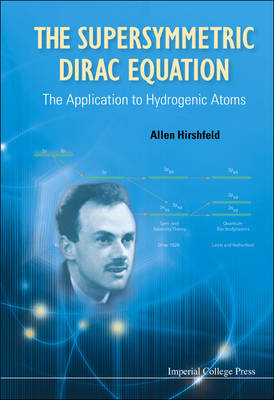
Supersymmetric Dirac Equation, The: The Application To Hydrogenic Atoms
Seiten
2011
Imperial College Press (Verlag)
978-1-84816-797-1 (ISBN)
Imperial College Press (Verlag)
978-1-84816-797-1 (ISBN)
Treats the solution of the Dirac equation for an electron in a Coulomb field by utilizing fresh insights provided by supersymmetry. This title shows that these concepts have their analogue in the non-relativistic cases. It develops the non-relativistic case, in order to introduce the various concepts in a familiar context.
The solution of the Dirac equation for an electron in a Coulomb field is systematically treated here by utilizing new insights provided by supersymmetry.It is shown that each of the concepts has its analogue in the non-relativistic case. Indeed, the non-relativistic case is developed first, in order to introduce the new concepts in a familiar context. The symmetry of the non-relativistic model is already present in the classical limit, so the classical Kepler problem is first discussed in order to bring out the role played by the Laplace vector, one of the central concepts of the whole book. Analysis of the concept of eccentricity of the orbits turns out to be essential to understanding the relation of the classical and quantum mechanical models.The opportunity is taken to relive the great moments of physics: From Kepler's discovery of the laws of motion of the planets, the development is traced through the Dirac equation up to modern advances, which bring the concepts of supersymmetry to bear on the derivation of the solutions.
The solution of the Dirac equation for an electron in a Coulomb field is systematically treated here by utilizing new insights provided by supersymmetry.It is shown that each of the concepts has its analogue in the non-relativistic case. Indeed, the non-relativistic case is developed first, in order to introduce the new concepts in a familiar context. The symmetry of the non-relativistic model is already present in the classical limit, so the classical Kepler problem is first discussed in order to bring out the role played by the Laplace vector, one of the central concepts of the whole book. Analysis of the concept of eccentricity of the orbits turns out to be essential to understanding the relation of the classical and quantum mechanical models.The opportunity is taken to relive the great moments of physics: From Kepler's discovery of the laws of motion of the planets, the development is traced through the Dirac equation up to modern advances, which bring the concepts of supersymmetry to bear on the derivation of the solutions.
The Classical Kepler Problem and Its Symmetries; From Solar Systems to Atoms; The Bohr Model and Its Quantum Rules; The Sommerfeld Model; Pauli's Group Theoretical Treatment of the Energy Levels of Hydrogen; The Inclusion of the Spin of the Electron; Elements of Supersymmetric Quantum Mechanics; The Dirac Equation and Its Conserved Quantities; The Johnson-Lippmann Operator; The Supersymmetry of the Dirac Equation in a Coulomb Field; The Solutions of the Dirac Equation and Their Relation to the Solutions of the Kramers' Equation; The Solutions in the Non-Relativistic Limit; Confluent Hypergeometric Functions and the Normalization of the Solutions.
| Verlagsort | London |
|---|---|
| Sprache | englisch |
| Themenwelt | Naturwissenschaften ► Physik / Astronomie ► Atom- / Kern- / Molekularphysik |
| Naturwissenschaften ► Physik / Astronomie ► Quantenphysik | |
| ISBN-10 | 1-84816-797-0 / 1848167970 |
| ISBN-13 | 978-1-84816-797-1 / 9781848167971 |
| Zustand | Neuware |
| Haben Sie eine Frage zum Produkt? |
Mehr entdecken
aus dem Bereich
aus dem Bereich
Buch | Softcover (2024)
Wiley-VCH (Verlag)
CHF 83,85


